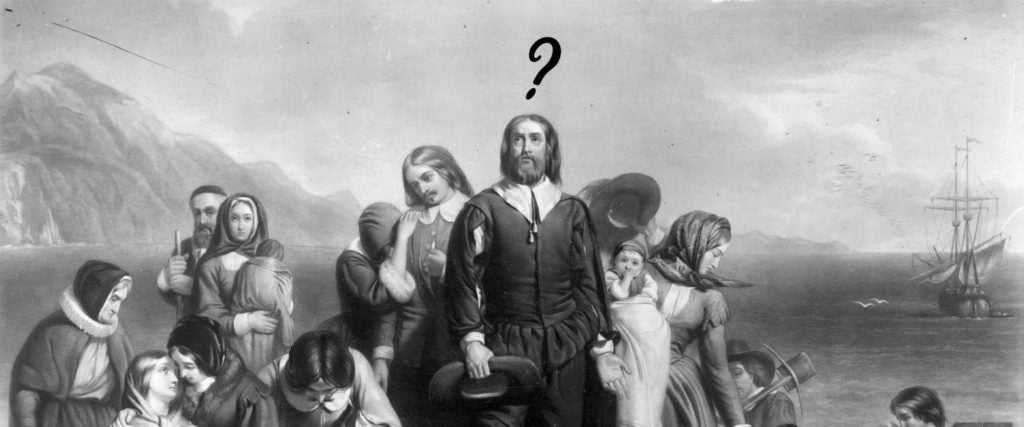If you’ve spent your life imagining the pilgrims with all-black, proto-goth outfits and a giant-buckled, pointy hat sitting on their heads, well, so do most Americans. It’s an iconic outfit, ubiquitous throughout pop culture, and one that’s been drilled into our minds usually starting with those simple, hokey elementary school lessons about the Mayflower arriving at Plymouth Rock.
It’s also almost totally wrong.
The pilgrims, who came to America in 1620 to escape religious persecution in England, wore the same colors other English people wore in the early 17th century. This included red, green, orange, blue and brown, which we know thanks to records of the pilgrims’ wills, which described what colored item of clothing was bequeathed to whom. The pilgrims did wear black clothing on occasion, but those occasions had to be very important, as dyeing clothes a truly deep, pure black was a difficult and expensive process. These outfits would only be worn for things like church and getting their portraits painted, which, since our only pictures of pilgrims is through their portraits, is why we’ve only seen them in their Sunday best, so to speak.
To be fair, history has gotten the better part of pilgrim fashion correctly. Men wore a linen shirt that reached to their knees as their undergarment. On top was a snug-fitting jacket called a doublet, which was buttoned in the front, then attached to knee-length shorts called breeches, so the latter didn’t fall down and scandalize the entire colony. Breeches could be tight or loose and baggy, but they were always worn well above the waist, as a doublet’s buttons stopped around the belly button. Some men might wear a ruff around their neck — you know, that big neck-platform-thing 16th-century folks like Shakespeare wore — while others just let the collars of their nightshirts hang out. Pilgrim men also wore felt caps (made out of beaver pelts, once they landed in America), or wide-brimmed hats to keep the sun out of their eyes and the rain off their heads.
Women, unsurprisingly, had to cover up a bit more. Their undergarment was a shift that reached all the way to their ankles, which was tightened by a stay — basically, a more functional, less sexy corset. The next layer included a waistcoat, which, like the doublet, was a tight, long-sleeved and buttoned jacket; below it was a petticoat, a long, roomy skirt made of linen or wool. Women invariably wore a wool apron over their petticoat for the usual reasons people wear aprons. However, wool had the unique benefit of not catching fire easily, which is rather helpful when you’re cooking with and next to a large fire or burning hot stove. For their headwear, women tucked their hair in a linen cap called a coif, which was topped off by a felt hat of their own.
Both men and women wore stockings in lieu of socks, which were held up by garters or ribbons. Finally, they would put on ratchet shoes, which are a little hard to describe (you can look for yourself), but used a leather tie to keep them attached to the pilgrims’ feet. If it was cold, the pilgrims wore cloaks, and women might put on an extra petticoat or two (or more).
You will notice not a single buckle is present on any item of clothing on either outfit.
So why are we convinced that pilgrims were covered, literally head to toe, with buckles? There are several reasons, the first being that buckled hats came into fashion in the late 17th century, although they were mainly worn by the upper classes, and well after the original Mayflower pilgrims had passed on. Still, the timeframe is close enough to lead to confusion, and Victorian historians and artists tended to confuse the pilgrims with the stricter, more close-minded and brutally proselytizing sects of Puritans who came to the Massachusetts area in droves shortly after the pilgrims and took over.
In fact, thanks to Victorian-era romanticizing, most of what we think we know about the pilgrims is wrong. The pilgrims didn’t actually land at Plymouth Rock, but in another part of Cape Cod; after exploring a bit, they chose a place to settle down, which they ended up calling Plymouth Harbour. (As far as we know, the first time “Plymouth Rock” was ever mentioned by name was in the 18th century, and besides, it would have been incredibly hard to land a ship on a giant rock anyway.)
And while the pilgrims did set out from Plymouth, their path to America didn’t start there. When they first fled England because of religious persecution — they refused to join the newly formed and legally mandated Church of England — they went to Holland, and only decided to give America a shot 12 years later. They first set sail from Delfshaven, in the Netherlands, on a ship called the Speedwell and landed in Southampton, England, to join up with the Mayflower. There, they finally embarked on their great journey to America… until the Speedwell sprang a leak, forcing them to stop in comparatively nearby Plymouth so all the passengers could pile into the second ship.
While our elementary school lessons gloss over those facts, they’re not as egregious as the ones they omit entirely. Not all of the 102 passengers on the Mayflower were strictly pilgrims, nor were they the only pilgrims; the majority sailed to America later. More grimly, not all 102 Mayflower passengers made it to Plymouth Harbor — five died at sea and another 45 died during their initial, brutal winter in America. The 50 or so pilgrims who survived to eat the first Thanksgiving dinner in 1621, alongside their generous hosts in the indigenous Wampanoag tribe, had plenty to be thankful for.
They just didn’t have those damn buckled hats.

